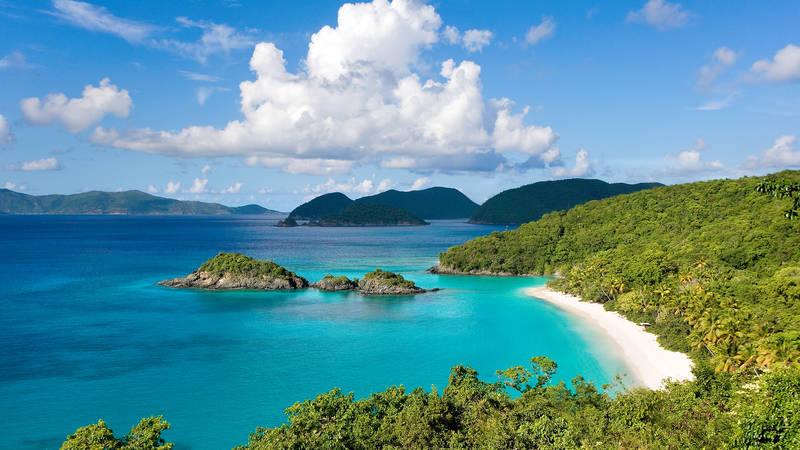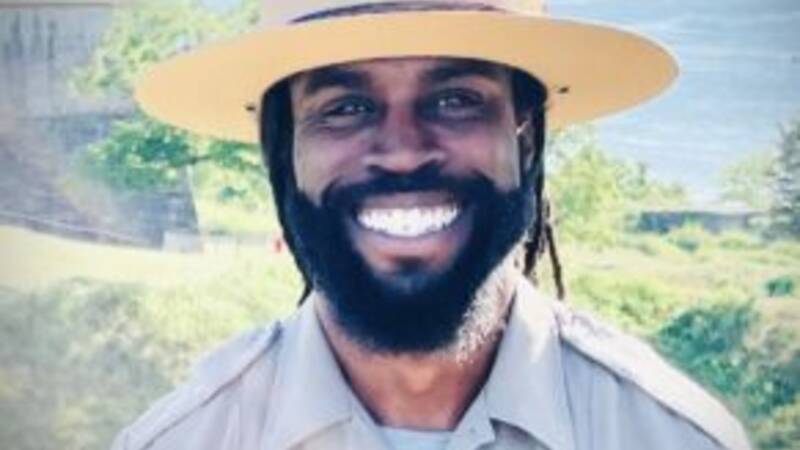Winter 2024
A Rebellion Reappraised
A new plaque at Virgin Islands National Park commemorates a revolt that nearly succeeded in upending St. John’s slaveholding establishment.
Sometime in the spring of 1734, according to some accounts, a few dozen men and women, perhaps Akwamu people from present-day Ghana, fled to a cliff at the southern tip of St. John, which is now part of the U.S. Virgin Islands. Exhausted and starving, the rebels took their own lives — possibly jumping to their death on the rocks below — rather than face certain torture from the European forces closing in on them. Their gruesome deaths ended a monthslong effort that shook the island’s slaveholding establishment to its core.
Though most of the 90,000-some residents of the U.S. Virgin Islands — 70% of whom are Black — likely know the broad brushes of the uprising and apparent suicide, many of the people visiting have never heard of it. It’s not an accident that this kind of story has long been overlooked, but rather an intentional effort to reshape history, said Ahmad Touré, the chief of interpretation at Virgin Islands National Park, which covers most of St. John and includes Ram Head, the presumed location of the rebels’ suicide.

9 Parks That Tell the Story of Slavery and Abolition
On June 19, the nation commemorates the end of institutional slavery in the U.S. These national parks are part of that long journey to freedom.
See more ›For centuries, plantation owners in the United States and the Caribbean perpetuated the myth of docile and content servants so they could keep the slavery-based economy going. Strategic warriors killing their captors and seizing the means of production, as the rebels did in St. John, didn’t fit that narrative. In addition, many of the remaining documents pertaining to the uprising reside in Denmark or the National Archives and the Library of Congress, where island scholars cannot easily access them. What’s more, those documents mostly feature the planters’ perspectives, and the Akwamu’s version of the story is difficult to piece together.
“It completely conflicts with the narrative that many Western countries and European powers are trying to tell people about slavery,” said Touré, whose mother is from the West Indies. “The Akwamu … knew their own strength. They were determined not to be kept in this undignified state.”
The events that unfolded on St. John nearly 300 years ago have never been commemorated with a monument or physical marker — but that’s about to change. In April 2022, Stacey Plaskett, who represents the U.S. Virgin Islands in Congress, introduced legislation directing the Department of the Interior to install a plaque memorializing the uprising at the peak of Ram Head. The resolution was included in a large appropriation bill that became law in December 2022, and the Interior Department is required to put up the plaque before Dec. 29.
Plaskett did not respond to requests for comment, but the plaque, her legislation reads, should “include information regarding important facts about the slave rebellion that began on St. John in 1733; the collective suicide that occurred during the slave rebellion in the vicinity of Ram Head on St. John in 1734; and the significance of the slave rebellion to the history of St. John, the United States Virgin Islands, and the United States.”

Virgin Islands National Park
Idyllic white-sand beaches and crystal clear seas draw many visitors to Virgin Islands National Park each year – and what waits underwater is just as breathtaking. The park includes 5,650…
See more ›The seeds of the St. John revolt were planted more than 70 years before the rebellion, when the Danes entered the slave trade by attacking Sweden and eventually taking over their operations in Accra, the area where Ghana’s current capital is located. The Akwamu ruled for several decades and traded with the Danes, selling their fellow Africans into slavery, until the conquered Tribal nations rose up and defeated them. The Akwamu, whose ranks were thick with warriors, were then sold into slavery themselves. Europeans bought them, bound them in chains and shipped them to the Caribbean throughout the early 1700s.
Between 1728 and 1733, records show that the number of enslaved men and women brought to St. John doubled, from 673 to 1,435, although the enslaved population was likely much bigger, according to historian Holly Kathryn Norton’s doctoral dissertation. St. John was an inhospitable environment for the settlers, as it was lacking fresh water, and its volcanic soil, which had allowed the island’s Indigenous people to grow staple crops such as cassava and potatoes, proved incompatible with the large-scale sugar operations the Danes hoped to establish. Most of the plantation owners preferred to live on nearby St. Thomas or in Copenhagen, according to Norton’s work published in the International Journal of Historical Archaeology, and enslaved people who escaped, known as maroons, lived off the land in a parallel universe to the plantation economy.
It is not clear if one event in particular spurred the revolt, but numerous accounts suggest the chaos on St. John may have convinced the Akwamu they could prevail. Droughts, hurricanes, disease and understaffed plantations made everyday life unstable. The fort built to protect the island from invaders sat mostly unmanned. Riches never came, in part because sugar didn’t grow well in those years, and as time went on, the Danes reported a dearth of food and medicine, as well as general misery.
The enslaved community plotted over furtive meetings and established a communication network. On Nov. 23, 1733, they entered the fort at Coral Bay carrying bales of wood, ostensibly a regular delivery. But once inside, they brandished their hidden cane knives and killed the soldiers. They went from plantation to plantation, killing colonists until they held much of the island.
The hapless Danes sent for European allies to vanquish the rebels and put the island back under European control. But those early calls went unheeded, and word of the rebels’ success spread through letters as English, French and Dutch visitors passed on the information. An English official who visited wrote: “On St. John the Danes at present hardly have possession. Their Negroes rose upon them about six months ago. At my first arrival I heard they had quelled their slaves, but it was not so. They have in a manner drove the Danes off, at least they dare not now attempt any more to reduce these Negroes, who have always beaten them, and in a manner are masters of that Island.”

Ahmad Touré, the chief of interpretation at Virgin Islands National Park, reached out to local historians and others to ensure the language on the plaque, memorializing the rebellion, would be right.
NPSThe words “slave rebellion” and “slave revolt” may conjure haphazard plans made in haste, but the 1733 takeover was the work of brilliant tacticians and strategic planners, Norton said. One of their leaders was the legendary Breffu, who reportedly killed her master and his wife and then went on to kill other slave owners. Today’s islanders often call her the Queen of St. John.
Norton, who is now the state archaeologist for Colorado, called the St. John uprising “an impressive effort that was very nearly successful in gaining long-term freedom for a group of enslaved people.”
Though one of the most effective uprisings, it did not ultimately succeed. Eventually, the Danes struck a deal with the French that resulted in forces from Martinique arriving and locating the rebels. They fought but could not hold off the French forces. The holdouts were left with few options. Those who did not commit suicide were killed in battle, tortured or recaptured.
That final stand and the events that led to it will be memorialized in the upcoming plaque, but before Touré finalized the plaque’s language, he researched the topic and sought feedback from local historians and others. After so long, he said, getting the story right is crucial.
Touré said park staff will likely do more to tell the story. Ram Head is a jagged, tough climb that many park visitors skip, so Touré is working with his colleagues to include additional signage in other parts of the park so that tourists and locals can learn more about the uprising. This reckoning with history is welcome for many islanders who have had a conflicted relationship with the park.

Protect America’s Coral Reefs from Irresponsible Development
Developers are looking to construct two different marinas in Coral Bay on St. John, US Virgin Islands, which is surrounded by the lands and waters of Virgin Islands National Park…
See more ›“Virgin Islanders have long been critical of what we would call the whitewashing of our history,” said Hadiya Sewer, director of the Virgin Islands Caribbean Cultural Center at the University of the Virgin Islands. “One of the main critiques that we see often is that the park does not do enough to give credit to Black and Indigenous people.”
Touré’s involvement, she said, gives her hope that the uprising will be presented from a Caribbean perspective. She has participated in a yearly pilgrimage and celebration to honor what many elder islanders call a “revolution.” Sewer, who grew up in the Virgin Islands and returned after several years of teaching at Brown and Stanford universities, said honoring that perspective is important. “They did indeed overthrow the government of their time, if only for nine months,” she said. “They were willing to be revolutionary. And in many ways, they paved the way for future generations of Black activists and revolutionaries.”
The insurrection, Sewer said, also elucidated what enslaved people brought with them when yanked from their former lives — experience with tools, maps and strategic thinking.
It’s not clear that the rebellion on St. John influenced uprisings in what would become the United States, said University of Maryland history professor Richard Bell, who has studied slavery extensively. But details would have reached Haiti, the location, some 60 years later, of the most successful slave revolution in history, and in turn the Haitian revolution inspired many of the mainland American revolts.
All of us, from the general public to academic historians, can benefit from being presented with the incontrovertible evidence that enslaved people dreamed of freedom every day of their lives.
These Caribbean insurrections certainly frightened plantation owners in the American colonies. They would talk about these threats over dinner, Bell said, without realizing that those serving the soup were listening and grasping for any hopeful tidbit.
With regard to slavery and race, new interpretive sites such as the one at Ram Head can counter whitewashing, said Bell, who is the author of “Stolen: Five Free Boys Kidnapped into Slavery and Their Astonishing Odyssey Home.”

National Parks
You can read this and other stories about history, nature, culture, art, conservation, travel, science and more in National Parks magazine. Your tax-deductible membership donation of $25 or more entitles…
See more ›“All of us, from the general public to academic historians, can benefit from being presented with the incontrovertible evidence that enslaved people dreamed of freedom every day of their lives,” Bell said. “Almost all slave revolts failed, and yet, by one count, more than 250 attempts were made. That is a very useful counterpoint to the lingering notion spread by proslavery forces over the last 500 years that Black people were content to be enslaved. That was a toxic fantasy, and every evidence of a slave revolt is proof of its malicious delusion.”
After he climbed Ram Head this spring, Touré threw a piece of coral off the cliff to see if it would land in the blue water below. It hit the rocks.
National park managers must be hyper-conscious about how they are sharing history, he said. “We need to be much more intentional about what we are doing and seek to break away from what has conventionally been taught and look to fill the gaps,” Touré said, “because we are the keepers of American history, and we are working in those places where history happened.”
About the author
-
 Rona Kobell Author
Rona Kobell AuthorRona Kobell, a frequent National Parks magazine contributor, is the co-founder of the Environmental Justice Journalism Initiative. She is also a professor of journalism and has written about the Chesapeake Bay for 20 years. Reach her at rona@ejji.org.


